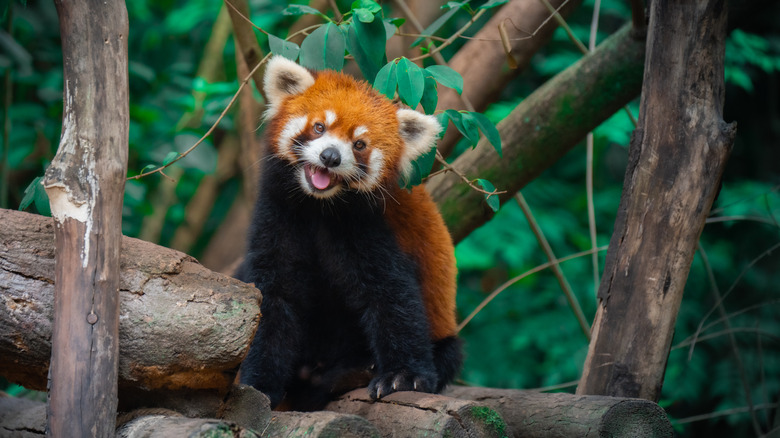What Are The Red Panda's Adaptations?
Red pandas are cat-sized mammals native to thick mountainous forests of the Himalayas and surrounding regions of southwestern China and Myanmar. Arresting in appearance with their large ears, dense cinnamon coats, and long, striped tails, these mostly nocturnal creatures are, despite their name, share more in common with raccoons and mustelids (weasels) than with the characteristics and behaviors of the giant panda that shares some of their range.
Threatened by habitat loss, red pandas are inherently at risk because of their relatively restricted diet. While they sometimes feed on small animals and other plants, most of their food comes in the form of widely abundant — but nutritionally challenging — bamboo. Red pandas adaptations have helped them survive, although they can't always help against their biggest threat: humans.
Red panda facts
The red panda's scientific name is Ailurus fulgens. It's part of the ailuridae family, but it is now the last existing species within this family, as all of the other species within it have gone extinct. Unfortunately, that may be the fate of this animal as well. They're about the size of a house cat with distinctive auburn fur.
The red panda is on the endangered species list, with less than 10,000 total individuals left in the wild. It's small habitat range has been severely impacted by climate change and human overuse. They're also often poached for their furs and are hunted accidentally after they get caught in traps set for other animals.
Dentition
The red panda has massive jaws relative to its size; its broad skull supports the attachment of strong chewing muscles. It also has 38 robust teeth. These adaptations help it mash up bamboo shoots and leaves, and they somewhat mirror those found in the giant panda, which also has heavy dentition and jaw muscles.
Red pandas tend to be more discriminating in their browsing, however. Where giant pandas will consume nearly every above-ground part of a bamboo plant in a rough manner, the red panda usually selects the more tender new growth of stem and leaf, and it chews more fastidiously.
Red panda thumbs
Another morphological similarity between the giant panda and the red panda is a thumb-like spur on the forepaw. While not a true thumb, this growth — a modified radial sesamoid bone — has evolved to fulfill a similar function: bracing against a shoot of bamboo while the panda gnaws or clips off leaves.
Arboreal habits
Red pandas are excellent climbers, sleeping during the day and seeking protection from predators in trees. Flexible paws give them the maneuverability necessary to descend a trunk headfirst, to leap from branch to branch, and to secure themselves in an arboreal nook for sleeping. The paws are furred on the sole, bolstering their traction on slippery branch-tops.
The animals sport sharp, semi-retractable claws for climbing. The red panda's long, luxuriously coated tail is an excellent balancing rod for canopy locomotion.
Red panda adaptations: behavioral
Like giant pandas, red pandas must feed often and extensively because they possess the simple digestive tract of a carnivore and are thus inefficient processors of their cellulose-heavy bamboo fodder. They may spend 13 hours a day foraging on bamboo, and do their best to conserve energy on this low-nutrition diet.
They stay warm during the winter cold with thick fur coats and by curling their long tails around themselves while sleeping; they maintain large home ranges that overlap broadly to reduce feeding pressure in any one area. Energy expenses are greatest for pregnant and nursing females — the Philadelphia Zoo reports a lactating mother may need to eat three times the normal quantity of bamboo to produce adequate milk — and the development of the cubs is slow and drawn-out.
